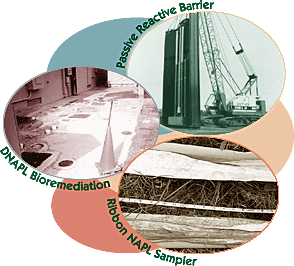
Since the last Initiatives spotlight on the Subsurface Contaminants Focus Area in the December 1998 issue, SCFA has embraced a best-practices, businesslike approach in helping its clients at DOE sites address their subsurface contamination problems. In an era of limited budgets for the development of new technologies, SCFA is focusing on ways to bring the benefits of currently available technologies to its clients while also working to bring to maturity the science and technology projects with the highest potential impacts. SCFA-sponsored projects are closely aligned to user needs, and the focus area is tailoring today’s technologies and tomorrow’s plans for direct application to specific sites. Shaping a technical
assistance process
To check out the process for requesting technical assistance from SCFA, go to SCFA's Lead Laboratory Technical Assistance Status Board. From here you can obtain a form for requesting assistance and can read about DOE’s environmental expertise found throughout the national laboratory complex, SCFA’s long-range technical vision, and SCFA products that have been generated as a result of providing technical assistance. A model case of technical
assistance at Paducah Already in place and functioning at the site to accelerate the acceptance and use of new technologies were two organizations that SCFA counts among its venues for offering technical assistance: the Innovative Treatment Remediation Demonstration and TechCon. ITRD is a DOE initiative for coordinating DOE, EPA, and regulatory agencies in evaluating, implementing, and validating innovative remediation technologies at selected DOE sites. TechCon is another technical assistance program that tracks domestic and international technologies. When Paducah first requested technical assistance from SCFA in February 1999, SCFA used its connection to ITRD and TechCon to help set up a Technical Advisory Group. The TAG at Paducah includes Paducah DOE and contractor personnel; SCFA, ITRD, and TechCon representatives; representatives from EPA’s regional office as well as its Technology Innovation Office; Kentucky regulators; and experts from EPA laboratories and DOE’s national laboratories. The TAG’s recently completed Innovative Technology Review Report contains approximately 30 technologies that have potential application to enhancing the remediation of the Paducah’s TCE and Tc-99 groundwater contamination. The SCFA-led Deployment Assistance Team that visited Paducah in November 1999 reviewed a working copy of the TAG’s Innovative Technology Review Report in developing its specific recommendations to accelerate groundwater cleanup. Star performers are
"step-change" solutions
Testing of DNAPL technologies
continues at Cape Canaveral In January, IDC hosted a tour for nearly 300 technology end users, regulators, and other stakeholders. Vendors from IT Corporation, Current Environmental Solutions, and Integrated Water Technologies presented their respective technology installations: In Situ Chemical Oxidation Using Potassium Permanganate (OST/TMS ID 167), Six-Phase Soil Heating (OST/TMS ID 5), and Dynamic Underground Stripping (OST/TMS ID 7) combined with Hydrous Pyrolysis/Oxidation (OST/TMS ID 1519). Tour attendees also learned about innovative DNAPL characterization tools (like the Ribbon NAPL Sampler [OST/TMS ID 2238] featured in Initiatives, Spring 2000) that have been tested at the site and about the pre- and postdemonstration performance assessment of the three technologies. Performance assessments will be conducted in accordance with EPA’s Superfund Innovative Technology Evaluation (SITE) program. Cost and performance will be available later this year. In characterizing the three test cells, EPA and Battelle systemically determined the location and number of coring samples to take to assess the total mass of trichloroethylene present in the test cells. By comparing postdemonstration cores with the samples taken before technology testing began, SITE will determine the relative performances of the cleanup technologies. SCFA plans to distribute quarterly e-mail updates on the side-by-side demonstrations to tour attendees and other interested parties. To receive updates, contact Emily Charogu at EnviroIssues at (206) 269-5041, echaroglu@enviroissues.com. What lies ahead? For more information on the Subsurface Contaminants Focus Area, see its Web site at http://www.envnet.org/scfa. |


